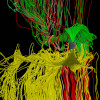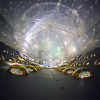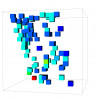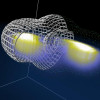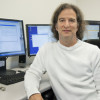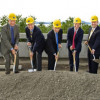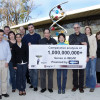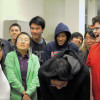News Center
John Bell Elected to National Academy of Sciences
John Bell, an applied mathematician and computational scientist who leads the Center for Computational Sciences and Engineering at Lawrence Berkeley National Laboratory, has been elected to the National Academy of Sciences. Read More »
Visualizing Processes That Lead to “Cracks” in the Earth’s Cocoon
Earth is mostly protected from solar radiation, by the magnetosphere. But sometimes the magnetosphere “cracks,” allowing radiation to seep in and wreak havoc on power grids and satellites. This phenomenon is not well understood, so scientists from UC San Diego ran simulations to investigate what happens. In the process, they generated approximately 3 petabytes of data, and reached out to Berkeley Lab’s Burlen Loring to develop customized visualization techniques for analyzing data. Read More »
Berkeley Lab-led Institute to Help Solve Data-intensive Science Challenges
Energy Secretary Steven Chu announced a $25 million five-year initiative to help scientists better extract insights from today’s increasingly massive research datasets, the Scalable Data Management, Analysis, and Visualization (SDAV) Institute. SDAV will be funded through DOE’s Scientific Discovery through Advanced Computing (SciDAC) program and led by Arie Shoshani of Lawrence Berkeley National Laboratory (Berkeley Lab). Read More »
Researchers Discover a New Kind of Neutrino Transformation
Some unprecedentedly precise measurements from the Daya Bay Neutrino Experiment are revealing how electron antineutrinos “oscillate” into different flavors as they travel. This finding may eventually solve the riddle of why there is far more ordinary matter than antimatter in the universe today. Read More »
Carbon Dioxide Catchers
CRD's Maciej Haranczyk and colleagues have developed a computational tool that can help researchers sort through vast databases of porous materials to identify promising carbon capture candidates—and at record speeds. They call it Zeo++.
Read More »
John Shalf's Paper is Among the Best in History of HPDC Conference
“The Cactus Code: A Problem Solving Environment for the Grid,” a paper co-authored by John Shalf of the Computational Research Division, has been selected as one of the top papers in the 20 years of publications from HPDC, the International ACM Symposium on High-Performance Parallel and Distributed Computing (HPDC). Read More »
Berkeley Lab Mathematicians Win Cozzarelli Prize
James Sethian and Robert Saye, mathematicians who both hold joint appointments with the Lawrence Berkeley National Laboratory (Berkeley Lab) and the University of California (UC) Berkeley, have won the 2011 Cozzarelli Prize for the best scientific paper in the category of Engineering and Applied Sciences. Read More »
Breaking Ground on the Computational Research and Theory Facility
Energy Secretary Steven Chu, along with Berkeley Lab and UC leaders, broke ground on the Lab’s Computational Research and Theory (CRT) facility, Wednesday, Feb. 1. The CRT will be at the forefront of high-performance supercomputing research and be DOE’s most efficient facility of its kind. Read More »
Billions of Genes and Counting!
Developed by CRD's Biological Data Management & Technology Center, the IMG/M data management system, which supports the analysis of microbial communities sequenced by the Joint Genome Institute, crossed the boundry of 1 billion genes recorded in the system—more than any other similar system in the world. Read More »
Inspiring Careers in Science Research
In an effort to expose high school students to careers in science research, the Lawrence Berkeley National Laboratory’s (Berkeley Lab) Computing Sciences Diversity Outreach Program partnered with San Francisco’s Lowell High School research program. Read More »










